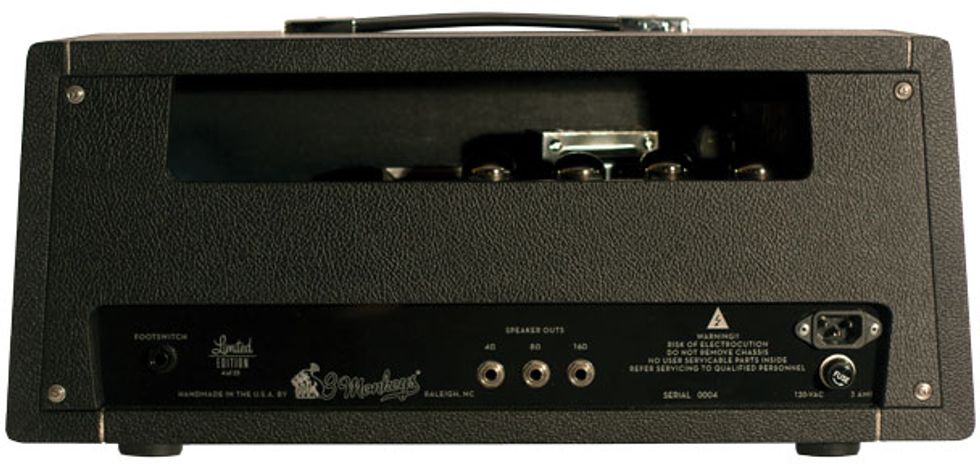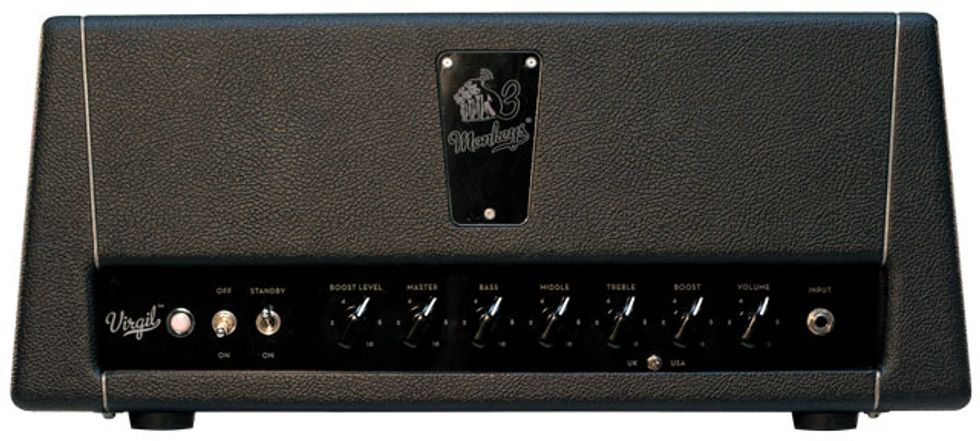Cofounded by Aerosmith’s Brad Whitford, renowned guitar tech Greg Howard (who works with Aerosmith, Green Day, and Linkin Park, among others), and former Blockhead Amps mastermind Ossie Ahsen, 3 Monkeys is one of the most buzzedabout amp-makers around. The company’s latest offering—the limited-edition Virgil—is a 30-watt, two-channel, 6V6-powered amp based on the Hiwatt-meets-Marshall BW119 that 3 Monkeys designed for Whitford in 2006. It’s also an amp that’s turning up in the rigs of such tone zealots as Steely Dan’s Walter Becker (who rocks a sweet surf-green model)—an early sign that 3 Monkeys is on to another winner.
No Monkey Biz
The streamlined front panel gives Virgil an
understated elegance. From left to right,
you’ll find on/off and standby switches,
knobs for boost level, master, bass, middle,
treble, boost (channel 2 gain), and volume
(channel 1 gain). Underneath the knobs is
a UK/USA voicing toggle that allows you
to switch between British or California EQ
voicings. The rear panel contains just a
footswitch jack and three speaker outputs
(4Ω, 8Ω, and 16Ω).
Although the amp looks just as sharp as its namesake (former WWF wrestler Ted “The Million Dollar Man” DiBiase’s bow-tied bodyguard, “Virgil”), there’s also substance aplenty beneath its handsomely outfitted exterior. First-class, hand-selected military-spec components—including Bourns pots and Orange Drop caps—are wired to a hybrid eyelet board, and the whole amp looks and feels clean, tight, and solid at the seams.

Million-Dollar Tones
Although 6V6 amps aren’t necessarily
known for having a ton of headroom, with
both the volume and master at around 4
and a Celestion-equipped 4x12 cabinet at
the receiving end of the signal, Virgil had
no problem keeping up with a loud band.
And using both a Japanese Fender Strat
and a humbucker-loaded Hamer Artist, I
was able to easily cut through the mix no
matter how dense it got.
The preamp is equipped with three 12AX7 tubes, and even when it was pumping out higher-gain sounds with lots of sustain, it never crossed over into the very compressed sorts of tones that some other high-gain amps are known for. In fact, when set to more aggressive tones, Virgil offered a clear sound that was still great for overdriven open chords and more organic-sounding lead tones. Even when I had the boost level set high (around 8), my sounds were still very articulate and evenly weighted. I could fingerpick double-stop sixths on nonadjacent strings and have each note come out razor sharp—but not brittle—and then follow up with long, single-note flurries without losing any sense of mass. I was struck over and over again by what responsive amp Virgil is.
Depending on the context, Virgil can be aggressive when unleashed or confidently reserved when waiting to attack. The amp is incredibly touch sensitive and can go from a whisper to a dynamic pop, depending on how hard you pick the strings. Virgil also cleans up incredibly well, even at high boost levels. In fact, at a band rehearsal I played most of the night with the boost channel and simply used my guitar’s volume knob to transition from clean to dirty. I enjoyed the range I got through that simple approach so much that I would have worked with those tones all night if I didn’t know I had to give the normal channel a spin just for the sake of thoroughness in this review. But going from the normal channel to boosted sounds via the included footswitch also proved to be extremely gratifying. There were no extraneous pops or clicks when changing channels (as happens sometimes on other channel-switching amps), and though both channels share the EQ section you shouldn’t have any issues finding a good EQ setting that works well across both channels unless you’re looking for an extreme contrast between sounds.
The Voice of Virgil
Creating an amp capable of pugnacious
Marshall-style dirt and angelic Fendertype
cleans has long been one of the
amp world’s most elusive ideals. And
while British-style pronounced mids and
blackface-like scooped mids are available
through Virgil’s UK/USA switch, you
can’t assign a given voice to individual
channels. I contacted 3 Monkeys to see if
there might be a mod available to provide
they said it may be an option in the future.
Just for kicks, I pulled out a classic 6V6 amp, a 1965 Fender Deluxe Reverb, to compare with Virgil in the USA mode. I was rather surprised to find that I preferred Virgil’s fuller voicing—to my ears, it was less scooped and richer sounding than the Deluxe Reverb. That said, Virgil isn’t necessarily intended to be a Fender or Marshall clone, it just uses those voices as a reference point.
I’m a big reverb fan, and when I try reverb-less amps it takes time for my ears to warm up to the dry sound. Virgil doesn’t have reverb—or an effects loop for patching one in post-EQ—but I was surprised again when the sound was so three-dimensional and ballsy that I didn’t miss it at all. Of course, if your sound is heavily reliant on reverb or delay, you’ll want a good reverb pedal, rack, or outboard unit to augment Virgil’s richness.
The Verdict
Although Virgil’s tones are rooted in classic
rock, it would be a mistake to think it’s
only suitable for rocking tones. From pop
to funk, country, and jazz, there really isn’t
any sonic territory the amp can’t cover.
And when you factor in the top-shelf components
and quality workmanship, Virgil
is an impressively complete amplifier.
Whether you’re bound for the studio or
stage, it’s a rig that kills.
Buy if...
you want a killer channel-switching tone machine that’s still quite simple to operate.Skip if...
you need reverb or an effects loop.Rating...









![Rig Rundown: Russian Circles’ Mike Sullivan [2025]](https://www.premierguitar.com/media-library/youtube.jpg?id=62303631&width=1245&height=700&quality=70&coordinates=0%2C0%2C0%2C0)


























